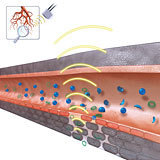by
Barbara Kram, Editor | August 05, 2009

Ultrasound-mediated gene therapy
Eindhoven, Netherlands -- Royal Philips Electronics (NYSE: PHG, AEX: PHI) and GlyGenix Therapeutics, Inc. (Woodbridge, Connecticut, USA) have announced a joint research agreement to explore the feasibility of using ultrasound technologies for gene therapy.
In particular, the collaboration will research the treatment of Glycogen Storage Disease Type 1a (GSD-1a) in pre-clinical studies. The collaboration unites Philips' expertise in medical imaging technologies for diagnosis and minimally-invasive medical procedures with GlyGenix's expertise in correcting the genetic defect in GSD-1a.
"The potential to deliver genes using a targeted approach will be a significant advance for correcting genetic defects and could offer the prospect of curing hereditary diseases such as GSD-1a," commented William Fodor, CSO of GlyGenix Therapeutics, Inc. "Philips' ultrasound-mediated DNA delivery techniques offer the opportunity to deliver genes without the size constraints and limitations of viral packaging systems, and thus open the door to the development of more robust and effective therapeutic genes."



Ad Statistics
Times Displayed: 137929
Times Visited: 7957 MIT labs, experts in Multi-Vendor component level repair of: MRI Coils, RF amplifiers, Gradient Amplifiers Contrast Media Injectors. System repairs, sub-assembly repairs, component level repairs, refurbish/calibrate. info@mitlabsusa.com/+1 (305) 470-8013
"Medical imaging systems already play a crucial role in minimally-invasive medical procedures such as opening obstructed arteries, correcting heart rhythm disorders, or sampling tissue biopsies of suspected lesions," said Henk van Houten, senior vice president of Philips Research and head of the Healthcare research program. "The development of ultrasound techniques that could non-invasively target the delivery of drugs, genes and stem cells to specific parts of the body opens up further possibilities to advance patient care."
Imaging technologies, notably ultrasound, are finding new applications in many medical interventions.
"We see medical imaging technologies being used increasingly to guide interventional procedures. Ultrasound can also be used to deliver therapy under image guidance as is being done in this case," explained M. D. Pashley, PhD, Research Department Head Ultrasound Imaging and Therapy, Philips Research NA. "Ultrasound can deliver energy to a local region of the body in order to deliver therapy. Localized drug delivery is one example. High intensity focused ultrasound (HIFU) is already being used to treat uterine fibroids and may provide new treatments for some cancers," Dr. Pashley told DOTmed News.
Targeting a Rare, Inherited Disease
GSD-1a is an inherited disease that makes it impossible for the body to regulate blood sugar (glucose) levels, due to a defective G6Pase gene that prevents the body from producing an enzyme called glucose-6-phosphatase. Although it is a rare disease, only affecting around 1 in every 100,000 to 200,000 births in the USA, it results in a significant reduction in patients' quality of life and can lead to potentially life-threatening co-morbidities in early adulthood. Currently, there are no approved curative treatments for GSD-1a. Correcting the genetic defect that causes it could offer the prospect of an effective therapy that would allow patients with GSD-1a to lead a normal life.

